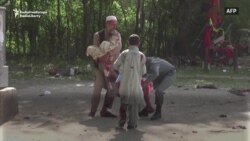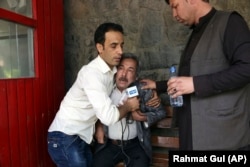Two years before his death, Shah Marai, the chief Kabul-based photographer for the French news agency Agence France-Presse, pondered the hopelessness that he said had descended on his native country of Afghanistan.
"The signs of war have all but disappeared," Marai wrote in the 2016 blog post. "But there is no more hope."
"I don’t dare to take my children for a walk. I have five and they spend their time cooped up inside the house. Every morning as I go to the office and every evening when I return home, all I think of are cars that can be booby-trapped, or of suicide bombers coming out of a crowd," he wrote.
Marai was one of at least nine journalists killed in Afghanistan on April 30, in what has turned into the deadliest single day for reporters in the war-torn country since the 2001 U.S. invasion. The killings bring the death toll among reporters working in the country since 1994 to at least 44, according to the Committee to Protect Journalists.
"This latest attack on journalists in Afghanistan is a reminder of the extreme dangers to media workers in that country and of the extremely brutal tactics used there by enemies of the free press," Steven Butler, the committee’s Asia program coordinator, said in a statement. "The attack amounts to an assault on Afghan democracy as the nation prepares for parliamentary elections scheduled for October."
"Today's bombing killed more journalists than any other single attack since the fall of the Taliban government in December 2001," the journalism watchdog Reporters Without Borders said.
In all, at least 25 people were killed in the twin suicide bombings in the capital, Kabul. Much of the carnage inflicted on reporters came at the hands of a second suicide bomber who was disguised as a cameraman. The reporters were among the group that was reporting on the first bombing.
Two journalists from RFE/RL’s Radio Free Afghanistan -- Abadullah Hananzai and Sabawoon Kakar -- were killed; a third who died, Maharram Durrani, was scheduled to begin working for RFE/RL in mid-May. Later on April 30, a BBC reporter was also shot dead in the eastern province of Khost.
'Crushing' News
The fears Marai expressed in his blog reflected that of the country’s press corps. In recent years, as Western attention and investment in Afghanistan has waned, the core of the country's journalism community remained locals, rather than foreign correspondents from Europe, North America and elsewhere. Many knew each other going back years, and mourned those who became casualties.
"These were my brothers, my sisters, my family. I hate to see this," said Candace Rondeaux, a former Washington Post correspondent in Kabul who later worked as a strategic advisor to the U.S. Special Inspector General for Afghanistan Reconstruction. "It’s crushing."
Five days before his own death, Hananzai posted a lament on Facebook for a reporter colleague who had died in the southern city of Kandahar, calling him a "martyr for the freedom of expression."
Responsibility for the Kabul bombings on April 30 was claimed by Islamic State militants, who said in a post to the Telegram messaging app that a "martyrdom brother" detonated a vest among "apostates."
'Soft Targets'
Journalists, along with aid workers, have long been "soft targets" in the country for militant attackers from groups like the Taliban, Al-Qaeda, and Islamic State.
"The substantive difference with today's attack is that it really comes at a time when certain elements of the insurgency are focused on voter suppression and fear and intimidation," said Rondeaux, now a professor of practice in Arizona State University’s School of Politics and Global Studies.
Afghanistan has seen a marked uptick in violence in recent weeks.On April 22, a suicide bomber killed 57 people and wounded over 100 more at a voter registration center in Kabul. People were targeted as they waited in line to collect identity cards to vote in long-delayed legislative and district council elections scheduled for October.
Rondeaux said the failure to protect journalists and others rests first and foremost with the Afghan government.
"And the reason this kind of attack is possible is not just that the security forces and police lack the capacity to protect," Rondeaux said. "It’s that corruption is so rampant in that country, in that city. People travel around with weapons targeting anyone that interferes with their agenda."
"The Afghan government cannot get a hold on corruption. [Attackers] slip through barriers, around boundaries, nine times out of 10, with the willing assistance of security forces who can be bribed to look the other way," she said.
The lament is echoed in Marai's 2016 blog, where he recalls the heady days of relative freedom after the U.S. invasion, and then the return of fear, which he said began in 2004.
"Afghans find themselves without money, without work, just with the Taliban at their doorstep," Marai wrote. "I have never felt life to have so little prospects and I don’t see a way out. It’s a time of anxiety."









